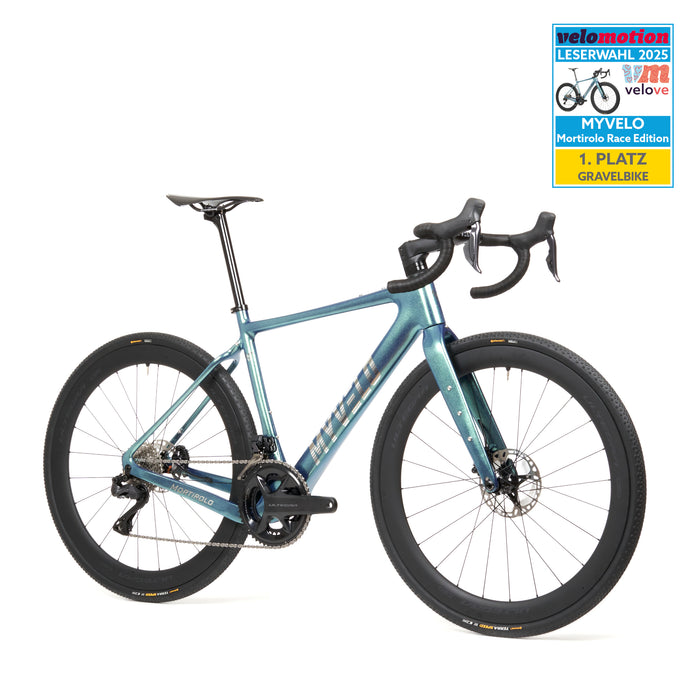
Mortirolo Gravel Bike - Race Edition
incl. FREE shipping & free returns

Von Vincent Augustin |
6 minutes read time

A rainy day can make riding a road bike a real challenge, sometimes even taking an adventurous turn. But what exactly changes in road cycling when the skies open?
This article will explain how wet roads affect handling and what the road cyclist is faced with in such situations. It will also discuss the role of the tire and how it affects the safety and efficiency of the ride. Prepare yourself for a fascinating journey into the world of road cycling in the rain.
Rain has an amazing ability to transform our streets and paint a completely new picture of our cities. When the first drops fall, a sparkling surface is created that turns streets, sidewalks and squares into shiny mirrors. They reflect the light from street lamps, shop windows and car headlights and immerse the surroundings in a magical sea of lights.
But there are more ways in which rain affects our streets. Firstly, it keeps them clean. Dust, dirt and waste are washed away, leaving a freshly washed surface. Secondly, rain also has a calming effect. The smell of fresh rain, known as "petrichor", has a calming effect on people, according to studies.
Another aspect is the soundscape. The splashing of the drops, the rustling of the leaves, the clicking of the umbrellas - all of this creates a very special atmosphere.
However, rain can also bring challenges, especially in terms of road safety. Wet roads can be slippery, visibility can be reduced and aquaplaning can be a risk. Therefore, it is important to drive carefully in the rain and increase your braking distance.
Overall, rain has an amazing ability to transform our streets and cities. It creates a unique atmosphere while also bringing challenges. So next time it rains, it's worth taking a closer look and discovering the many facets of rain.
If you don't want to leave your racing bike in the garage even when the weather is grey, there are a few important aspects you should consider when preparing.
First of all, the right clothing is essential. Make sure it is breathable, water-repellent and highly visible. The following are particularly important:
Your racing bike should also be well maintained. Check the tire pressure and brakes before every ride. On wet roads, the braking distance is longer and cornering can be slippery. It is all the more important that your brakes work perfectly.
The choice of route is also crucial. If the road is wet, avoid steep descents and choose flatter routes. Also note that road markings and leaves can be slippery.
Another important point is proper nutrition. The body burns more calories, especially in colder temperatures. Therefore, it is advisable to always have enough energy bars or gels with you.
Last but not least: don't let grey clouds put you off! With the right preparation, road cycling can be a great experience even in bad weather. It strengthens the immune system and improves riding technique in difficult conditions. And after the ride, a well-deserved warm drink awaits you. So, dress warmly, hop on your road bike and enjoy the ride!
Adapting your driving style is crucial to safely navigate wet roads. Here are the most important aspects to consider:
A 2019 study by the ADAC found that most accidents on wet roads are caused by excessive speed and insufficient distance.
Adapting your driving behavior on wet roads requires, above all, a foresighted and cautious driving style. Always consider what other road users might do and react early to avoid accidents.
And don't forget, your vehicle should also be prepared for wet conditions. In this sense: safety first!
Choosing the right tires plays a crucial role in driving safely in the rain. A good rain tire is characterized by a special rubber compound and a deep profile that can drain water quickly and thus prevent aquaplaning. This increases grip on wet roads, which in turn leads to better roadholding and shorter braking distances.
There are three key elements to consider when choosing tires:
It is especially important to check the tire pressure regularly when driving in the rain, as too low or too high pressure can have a negative impact on driving characteristics. Also drive with foresight and adapt to the weather conditions. By choosing the right tires and driving style, you can significantly increase your safety on wet roads.
After a long ride in the rain, taking care of your road bike is essential to ensure its performance and longevity. Here are five essential steps to keep your road bike in top shape:
These care tips will help you get your racing bike back in shape after a rainy ride and keep it in top shape. This way you can keep the joy of cycling for a long time and at the same time extend the life of your racing bike.
Although driving in the rain is often seen as a challenge, there is a special fascination in it. Between sunshine and cloudbursts, there are many reasons why driving in the rain is a unique experience. First, the background noise: the steady rhythm of the rain can have a calming effect. Second, the atmosphere: the dark clouds and the misty horizon give the landscape a mystical aura. Third, the technical challenge: driving in the rain requires special attention and a foresighted driving style.
However, there are also some important aspects that you should keep in mind to drive safely in the rain. Firstly, reduce your speed to minimise the risk of aquaplaning. Secondly, keep more distance from the car in front of you as your braking distance is longer on wet roads. Thirdly, check the function of your windscreen wipers and tyres regularly.
The fascination of driving in the rain is therefore a mixture of aesthetic impressions and technical challenges. It can be an intense driving experience that challenges your driving skills as well as touches your senses. But no matter how fascinating driving in the rain may be, safety is always the most important thing. With the right precautions and an adapted driving style, you can enjoy driving in the rain to the fullest.

Als Rennradfahrer möchte man möglichst ständig besser werden: schneller, ausdauernder und effizienter. Doch was, wenn der Schlüssel zu diesen Zielen nicht nur auf zwei Rädern liegt? Rudern, oft unterschätzt, bietet eine ideale Ergänzung zum Radtraining. Es trainiert nicht nur den ganzen Körper, sondern verbessert auch die Ausdauer, Kraft und Stabilität – entscheidende Faktoren für jeden Radsportler.

Nach einer intensiven Rennrad-Einheit ist die richtige Regeneration entscheidend, um Leistung zu verbessern, Verletzungen zu vermeiden und langfristig Fortschritte zu erzielen. Doch wie sieht eine effektive Erholung aus? Hier bekommst Du die besten Tipps zur optimalen Regeneration nach dem Rennradtraining.

Erfahre, wie Radsport-Ligen aufgebaut sind und weitere Infos zur Organisation im Profi-Radsport!